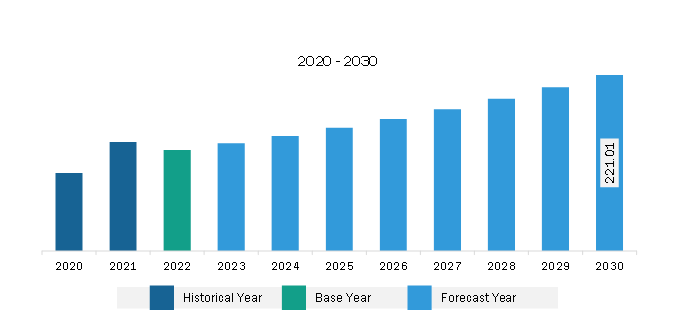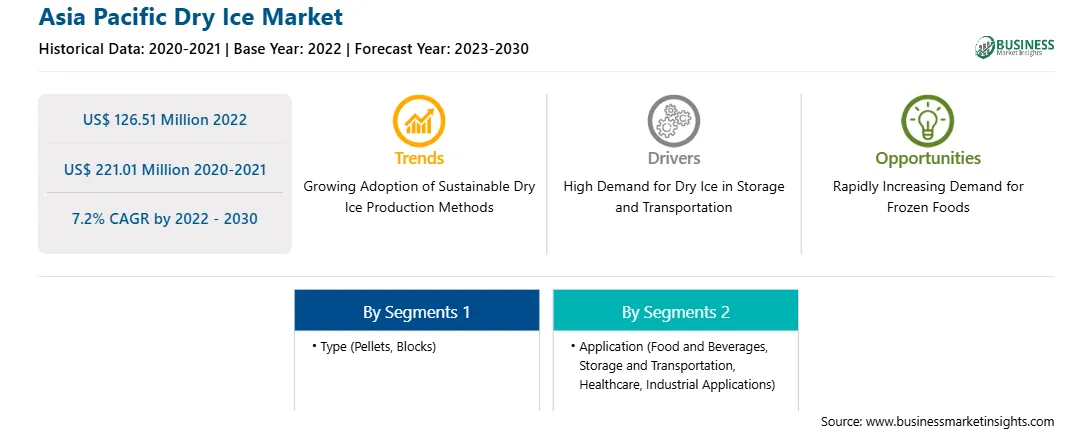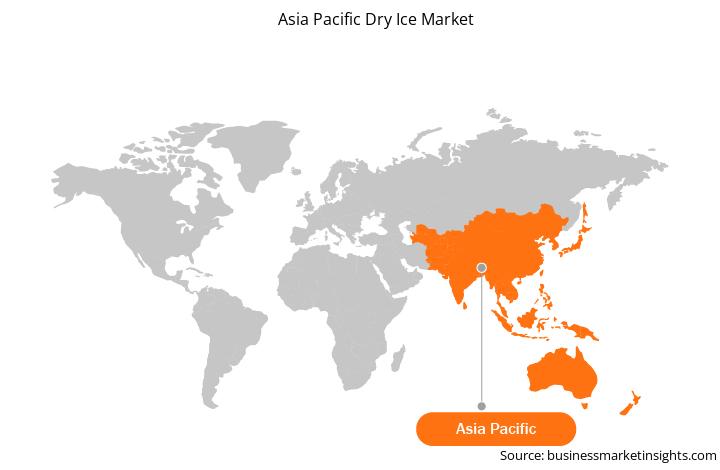The Asia Pacific dry ice market was valued at US$ 126.51 million in 2022 and is expected to reach US$ 221.01 million by 2030; it is estimated to register a CAGR of 7.2% from 2022 to 2030.
Rapidly Increasing Demand for Frozen Foods Boosts Asia Pacific Dry Ice Market
An increase in demand for frozen foods and a rise in the usage of dry ice as refrigerant in food and shipping industries are key factors anticipated to provide growth opportunities to the Asia Pacific dry ice market. Dry ice is carbon dioxide in its solid form. This dense, snowlike substance sublimes at −78.5 °C (−109.3 °F), used as a refrigerant, especially during the shipping of perishable products such as meats or ice cream. As the dry ice sublimes, it leaves no residue to contaminate or compromise the quality of food.
Over the past few years, the lifestyle of people globally evolved dramatically. Due to hectic work schedules, people are looking for products that save time and effort. Consumers prefer ready-to-eat, microwavable, and ready-to-prepare food products as they are highly recommended for on-the-go consumption and require minimal preparation time. Moreover, the increasing working women population, high per capita income, and a rising middle-class population are key factors driving the growth of convenience food consumption globally. Due to the increasing number of nuclear families, the demand for prepared-to-eat, portion-controlled food increased. The market for frozen food products is also growing as they have extended shelf-life, are suitable for single-person consumption, and can be prepared in less time. Dry ice plays a crucial role in preserving the quality and safety of these frozen food products throughout their storage, transportation, and distribution.
The high demand for frozen meat & poultry, and seafood owing to the increasing awareness among consumers regarding the health benefits offered by meat and seafood favors the market. These products are low-fat and high-protein foods that can help to build muscle, boost brainpower, improve eyesight, support heart health, relieve joint discomfort, and improve skin and hair. Consumers are shifting toward a healthy lifestyle, which has led to a high demand for healthy food with nutritional value. Unlike traditional water-based ice, dry ice sublimates, transitioning directly from solid to gas, eliminating the risk of moisture accumulation and freezer burn. This makes it an ideal cooling agent for frozen food, ensuring that products remain frozen and maintain their texture, taste, and nutritional value. Hence, the surge in demand for frozen food products is ultimately bolstering the dry ice market.
Asia Pacific Dry Ice Market Overview
The Asia Pacific dry ice market has increased demand for temperature-controlled logistics and distribution services for life science products and pharmaceuticals. This demand is fueled by factors such as population growth, increasing healthcare spending, and the expansion of the pharmaceutical industry in the region. The growth of the pharmaceutical industry in the region is directly influencing the growth of the dry ice market. As part of initiatives like Healthy China 2030 and similar initiatives in other Asian countries, healthcare infrastructure investments have been made, including clinics, hospitals, and research facilities. This development has enabled pharmaceutical companies to collaborate with healthcare service providers and expand their market presence, including clinical research and development. Asia Pacific is one of the significant markets for pharmaceutical products and is majorly driven by the rise in demand for generic medicines, an increase in healthcare expenditure, a surge in the geriatric population, a change in demographics, and greater accessibility to advanced treatments.
China, Japan, and India are the major producers of pharmaceuticals in Asia Pacific. The governments of these countries are developing new policies to promote the development of the pharmaceutical industry. For instance, to address the needs of the growing population in Japan, the government is responding by easing various life science regulations and surging approval of innovative new drugs to promote pharmaceutical companies, both in domestic and foreign markets, and dry ice is used in their shipment and storage as dry ice helps in maintaining the temperature. Favorable government policies for the development of the pharmaceuticals industry, coupled with the strong growth of the healthcare sector in the region, are favoring the growth of the dry ice market.
Asia Pacific Dry Ice Market Revenue and Forecast to 2030 (US$ Million)
Strategic insights for the Asia Pacific Dry Ice provides data-driven analysis of the industry landscape, including current trends, key players, and regional nuances. These insights offer actionable recommendations, enabling readers to differentiate themselves from competitors by identifying untapped segments or developing unique value propositions. Leveraging data analytics, these insights help industry players anticipate the market shifts, whether investors, manufacturers, or other stakeholders. A future-oriented perspective is essential, helping stakeholders anticipate market shifts and position themselves for long-term success in this dynamic region. Ultimately, effective strategic insights empower readers to make informed decisions that drive profitability and achieve their business objectives within the market. The geographic scope of the Asia Pacific Dry Ice refers to the specific areas in which a business operates and competes. Understanding local distinctions, such as diverse consumer preferences (e.g., demand for specific plug types or battery backup durations), varying economic conditions, and regulatory environments, is crucial for tailoring strategies to specific markets. Businesses can expand their reach by identifying underserved areas or adapting their offerings to meet local demands. A clear market focus allows for more effective resource allocation, targeted marketing campaigns, and better positioning against local competitors, ultimately driving growth in those targeted areas.
Asia Pacific Dry Ice Strategic Insights

Asia Pacific Dry Ice Report Scope
Report Attribute
Details
Market size in 2022
US$ 126.51 Million
Market Size by 2030
US$ 221.01 Million
CAGR (2022 - 2030) 7.2%
Historical Data
2020-2021
Forecast period
2023-2030
Segments Covered
By Type
By Application
Regions and Countries Covered
Asia-Pacific
Market leaders and key company profiles
Asia Pacific Dry Ice Regional Insights

Asia Pacific Dry Ice Market Segmentation
The Asia Pacific dry ice market is categorized into type, application, and country.
Based on type, the Asia Pacific dry ice market is segmented into pellets, blocks, and others. The blocks segment held the largest market share in 2022.
In terms of application, the Asia Pacific dry ice market is segmented into food and beverages, storage and transportation, healthcare, industrial applications, and others. The storage and transportation held the largest market share in 2022.
By country, the Asia Pacific dry ice market is segmented into Australia, China, India, Japan, South Korea, and the Rest of Asia Pacific. China dominated the Asia Pacific dry ice market share in 2022.
Linde Plc, Nippon Sanso Holdings Corp, Sicgil India Ltd, and SOL SpA are some of the leading companies operating in the Asia Pacific dry ice market.
The Asia Pacific Dry Ice Market is valued at US$ 126.51 Million in 2022, it is projected to reach US$ 221.01 Million by 2030.
As per our report Asia Pacific Dry Ice Market, the market size is valued at US$ 126.51 Million in 2022, projecting it to reach US$ 221.01 Million by 2030. This translates to a CAGR of approximately 7.2% during the forecast period.
The Asia Pacific Dry Ice Market report typically cover these key segments-
The historic period, base year, and forecast period can vary slightly depending on the specific market research report. However, for the Asia Pacific Dry Ice Market report:
The Asia Pacific Dry Ice Market is populated by several key players, each contributing to its growth and innovation. Some of the major players include:
The Asia Pacific Dry Ice Market report is valuable for diverse stakeholders, including:
Essentially, anyone involved in or considering involvement in the Asia Pacific Dry Ice Market value chain can benefit from the information contained in a comprehensive market report.